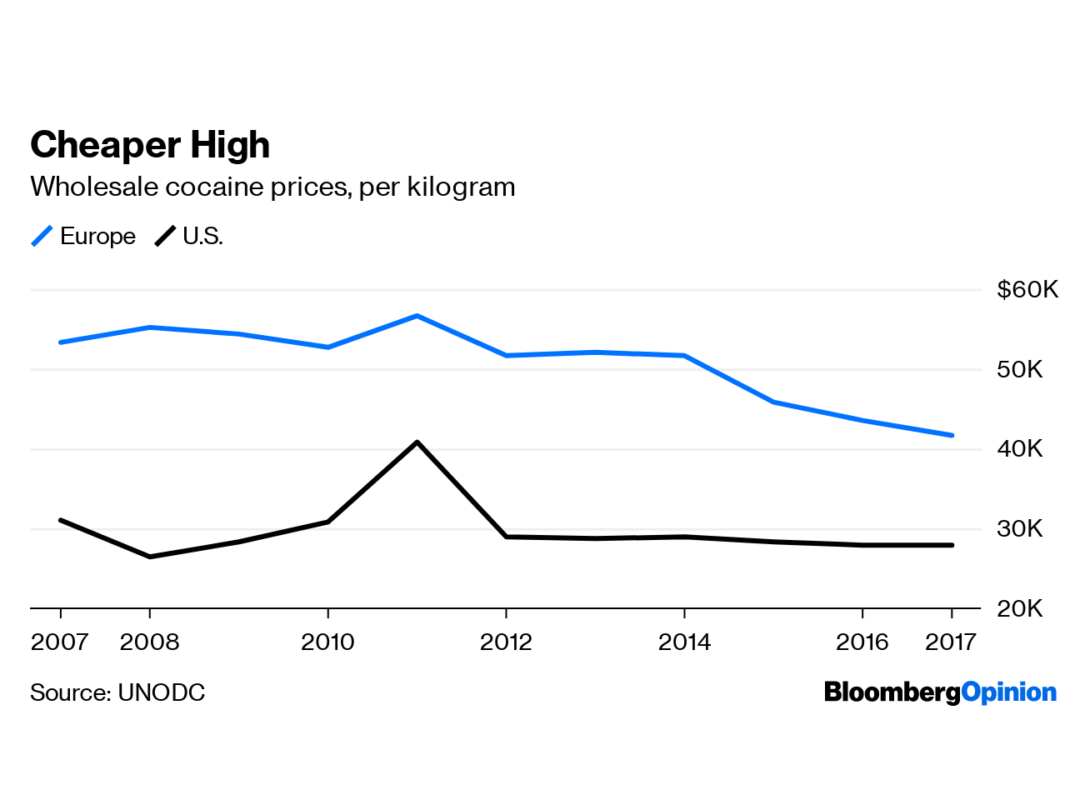
Visit Our Sponsors |
|
|
|
|
|
|
|
|
|
|
|
|
|
|
|
|
|
|
|
|
|
|
|
|
|
|
|
|
|
|
|
|
|
|
|
|
|
|
|
|
|
|
|
|
|
|
|
|
|
|
|
|
|
|
|
|

“Uberization of the cocaine trade”? That’s not a joke. Fresh reports on illegal drug use from the United Nations and the European Union show that the cocaine market is growing rapidly, and technological progress has a lot to do with it.
The opioid epidemic remains largely a U.S. phenomenon, driven by the high availability of medical opiates and poor policy responses; in Europe, opioid use is going down consistently thanks to pragmatic harm reduction policies that decrease the stigma of drug use and stress treatment rather than enforcement. In contrast to opioids, the use of cocaine is on the rise in both major markets, North America and Europe, according to the UN Office on Drugs and Crime.
Coking Up
The cocaine resurgence is fed by a growing supply. According to the UN, the estimated global manufacture of the drug hit the all-time record of 1,976 tons in 2017, the latest year for which data are available — more than twice as much as in 2013, and 25 percent more than in 2016. The main reason is that production in Colombia, the biggest coca-growing country, more than tripled between 2013 and 2017. That increase has been driven in part by a drop in antigrowing operations and in part by the pacification of Colombian guerrilla groups such as FARC; in some remote areas, where legal crops aren’t economically viable, the far-left guerrillas have been replaced by organizations with purely commercial rather than ideological motives.
According to the European Monitoring Center for Drugs and Drug Addiction, the cocaine sold to retail customers in Europe now is the purest in a decade, which means there’s plenty of it and there’s no need to cut it. Wholesale prices have been falling, more steeply in Europe, where they were high for geographical reasons, but also in the U.S.
Cheaper High
Retail prices have also dropped slightly in recent years, despite the higher purity. That’s because the market has changed.
Defying the widespread perception that young people today subscribe to healthier lifestyles than previous generations, people between the ages of 18 and 25 are the biggest cocaine-consuming demographic in both markets. One reason could be that the cocaine market has become technology-driven rather than thug-dominated and monopolized; it’s a modern, entrepreneurial and competitive marketplace. The EU drug agency wrote in its 2019 report:
A reorganization of the cocaine supply chain and the players involved is visible at the middle and retail level, with the emergence of fragmented, looser and more horizontal organizational structures. Smaller groups have been able to enter the market by using a range of information technology like encryption, darknet marketplaces, social media for dealing and cryptocurrencies. Entrepreneurship in the competitive cocaine market is evident from innovative distribution strategies, such as cocaine-exclusive call-centres. These new methods appear to reflect to some extent the type of disruption seen in other areas facilitated by the common use of smartphones — a potential ‘Uberization’ of the cocaine trade — a competitive market in which sellers compete by offering additional services such as fast and flexible delivery options.
Of course, darknet markets and other technology-assisted operations sell all kinds of drugs, but cocaine is especially well-suited to the modern distribution systems. A lot of socially well-adapted people use it recreationally, and they tend to order the drug in the same way as pizza. That’s where the call centers and cocaine cabs come in.
Cocaine’s other advantage in terms of building a modern market infrastructure is the high price per gram and the large differential between wholesale and retail prices. Cocaine retailers’ gross profit margins reached, on average, more than $40 per gram in 2017, while heroin retailers made about $25. Some of the profits go into building a slick infrastructure.
The rise in cocaine use is, in its own way, as worrying as the U.S. opioid epidemic, even if it’s not killing as many people. In Europe at least, the number of people seeking treatment for cocaine-related problems is up by 35 percent since 2014, and the drug is likely responsible for a hard-to-calculate number of deaths from cardiovascular disease. Cocaine’s recent ready availability and the lively, technologically advanced market are dangerous, primarily to young people.
The countries that form the biggest markets for the drug should do more to address the production increases in Latin America, perhaps offering more to farmers to switch to other crops than the Colombian government can. And in Europe and the U.S., there’s room for more tech-based approaches to weaning tech-savvy users off cocaine. The EU report, for example, mentions the use of virtual reality to induce drug cravings and train people to deal with them. The previous four decades’ extravagant “war on drugs” was largely unsuccessful, but that only means better, smarter ways should be found to tackle cocaine’s return.
RELATED CONTENT
RELATED VIDEOS
Timely, incisive articles delivered directly to your inbox.







